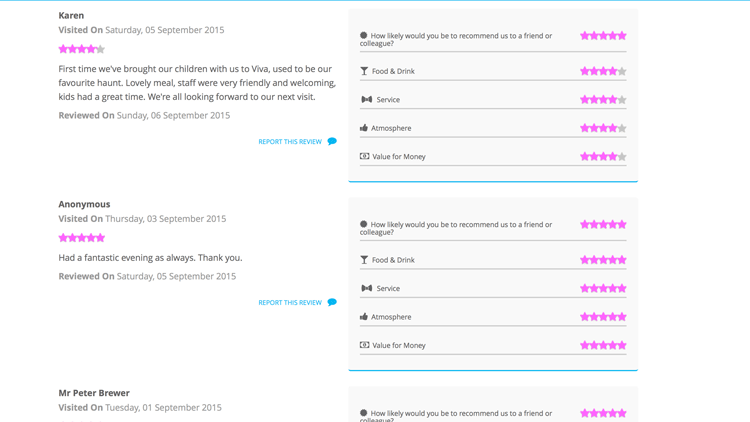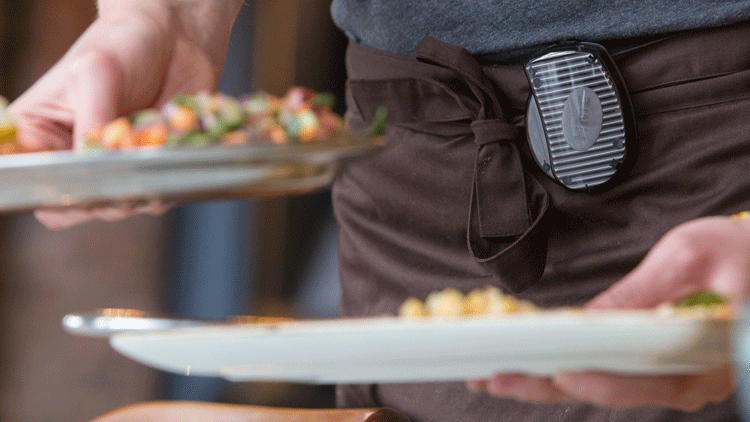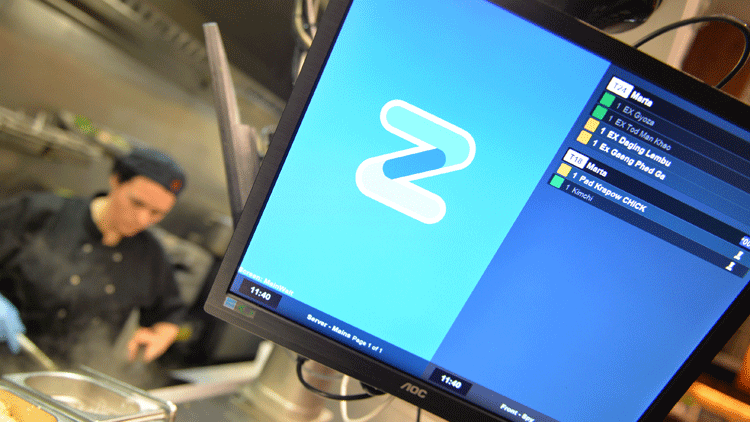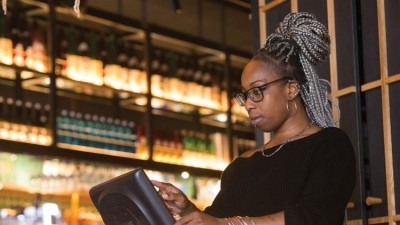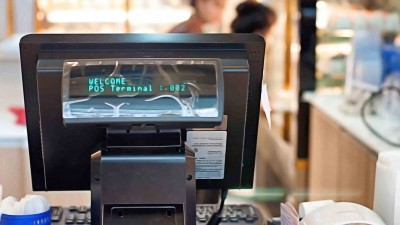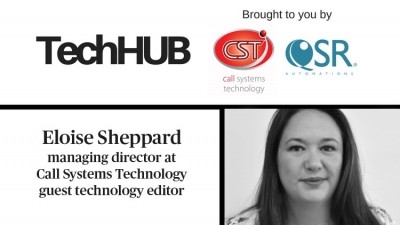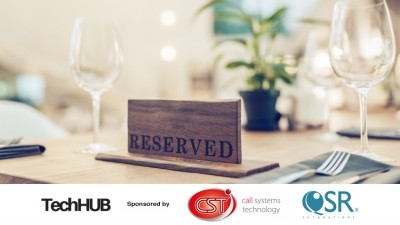Machine learning: what’s next for in-restaurant tech
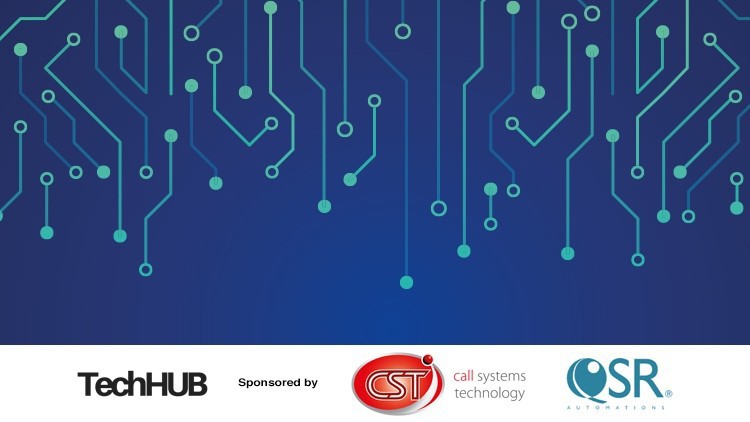
Technology has never before played such a major role in the running of a restaurant business. Whether you have one site or several, from electronic point of sale (EPoS) to kitchen management systems, bookings systems, ordering and payment systems and online feedback tools, there are technology solutions out there to enhance every aspect of restaurant operations. For our annual technology report, we’ve spoken to those at the forefront of these technologies to find out what you should look for when choosing the right system for you, plus what’s new and what’s on the horizon to help you run your business better.
Bookings and marketing
In this fast-paced, connected world, where consumers use the internet for almost everything, having the capacity to take online reservations is a must for restaurant operators. And with research by Zonal and CGA revealing that 60% of consumers use a smartphone to make a booking when out and about, it’s also important to choose an online booking facility that’s easy to use on a mobile device.
Zonal’s liveRES solution is built for mobile and touch screen, and can be configured to meet individual operator specifications and seamlessly integrate into their websites, which Zonal says guarantees brand consistency.
“Keeping control of your brand, data and online presence is vital, particularly when you consider the amount of ‘no-shows’ and the impact this has on the bottom line,” says Zonal’s Clive Consterdine. “In our experience, keeping all your marketing material brand authentic and building personal engagement with your customers will help to minimise no-shows. Tactics, such as personal reminder SMS messages on social channels can also serve as a great way to make sure people turn up for bookings.”
Restaurant reservations platform Quandoo advises restaurants to make use of improved pre-validation technology to reduce the incidence of no-shows. Vice-president Matt Simpkin says: “The restaurant sector still veers away from asking for deposits or taking credit cards as it reduces conversion of online bookings to visits. This tech is improving now though: pre-validation no longer requires money to be reserved from the diner’s bank balance for weeks on end, and pre-filled card details mean this is not a time-consuming task for diners as they complete their reservations.”
He adds: “However, restaurants should encourage people to use this facility with carrot rather than stick at first. For example, using our pre-order functionality, you can encourage people to use their card to make a pre-order of drinks on arrival at a special price.
“By integrating this to your mPoS (mobile point of sale) system and reservations system, the customer is presented with their pre-ordered drinks on being shown to their table, which is a real plus for diners. It increases your average bill size, removes the perceived hassle of leaving card details by combining it with an offer, and makes a no-show much less likely.”
ResDiary's customer reviews interface
Restaurant reservations provider ResDiary echoes Zonal’s advice to make sure you maintain your brand identity when choosing a bookings system. ResDiary CEO Mike Conyers says: “It’s easy to look at commission-charging booking sites and see them as an easy way to gain extra covers, but what people don’t consider is how much they can damage their brand by using them: when diners book through third-party sites, pre and post-booking communication comes with their branding, meaning the connection between the guest and the venue is lost. Then that diner’s information is held by the third party, meaning they are free to email them about competing restaurants nearby.
“This erosion of loyalty makes guests more likely to place future reservations through that third party, costing the restaurant in commission. It also increases the likelihood of no-shows.” ResDiary has its own booking portal at resdiary.com, but every venue’s personal microsite is customisable. Guest communication emails are designed by the restaurant itself, and restaurants also keep their own database and pay no commission on reservations.
Conyers advises that operators ensure their chosen bookings system is underpinned by an excellent table management system, and that they look for a system that’s always evolving to keep up with developments in technology.
As for the latest developments in marketing technology, Instagram is increasingly being used as a tool to reach potential customers, along with search engine optimisation (SEO). Conyers explains: “With recent data protection rules changing how restaurants reach customers, restaurants are looking at new ways to boost their marketing potential and one of the fastest growing ways they’re doing this is through social media. Instagram, with its 800 million users, is particularly popular. With Instagram’s sponsored posts and stories features, users can add a link that allows its huge audience to book directly with just a couple of taps. “It’s something that we at ResDiary have found to be particularly effective in bringing our customers incremental bookings,” says Conyers.
He adds: “The other aspect of restaurant marketing that’s gaining further traction is search engine optimisation. At present, 37% of internet users between the ages of 21 and 34 discover new brands through search engines.”
ResDiary recently relaunched a more search-engine-friendly portal to drive traffic and reservations for restaurants, and says venues are also starting to do this with their own sites.
EPoS
Your EPoS system is essentially the technology backbone of your business, with the latest till systems able to do so much more than just taking orders and payments. An intelligent EPoS system should be able to connect seamlessly with other technology to enhance operations across the board.
As Zonal’s Consterdine says: “EPoS should sit at the heart of your technology infrastructure and not be viewed as a stand-alone system – it needs to be integrated. Whether you are a multiple or single-site restaurant operator, through integrated technology, you can learn more about your customers, their behaviour and purchasing preferences than ever before.
“Zonal’s Aztec is designed to enhance the guest experience every step of their journey: from website to booking a table, to being served and settling a bill. “Happy guests drive loyalty, sales and profits, so investing in an EPoS system with integrated functionality, that can flex and grow with you, is essential to business growth.”
Tevalis sales director James Humble shares that view, advising that restaurant operators choose an EPoS system that can integrate and grow with your business. “Don’t buy for now, buy for the future. I have seen a strong shift away from stand-alone PoS technology where manual data entry into other third-party systems is required to get the analysis out the other end. “Our APIs (application programming interfaces) and bespoke project development are being used more than ever, with PoS technology now communicating with all front and back-office tools from finance such as Sage to CRM systems such as Salesforce,” he says.
As well as increased integration with other systems, the other big leap forward for EPoS has been the switch from fixed terminals to mobile devices. Zonal’s iServe product, an alternative to the traditional order pad, is proving a big hit with customers according to Consterdine, who says, it offers lower levels of investment and greater flexibility, giving staff the freedom to access Aztec EPoS functionality on an iPod or iPad.
Oracle reports a similar growth in the uptake of handheld PoS devices. Tim Brown, vice-president of global sales engineering at Oracle Food and Beverage, says: “The use of handheld devices and tablets for taking orders is definitely on the rise. Oracle Hospitality surveyed a group of restaurant operators in 2017 and 89% said they were either using tablets and other handheld devices already or were looking to do so in future. And for good reason – they speed up service, reduce errors, and help to keep tables turning at busy times. They can also be used for staff training and back-office functions.
“However, larger PoS terminals will remain in use – what is changing and will continue to change is the ratio of mobile to fixed devices.” Tevalis has also seen a shift from pen and paper ordering towards handheld technology solutions and in response redeveloped its handheld ordering platform this year, meaning operators can now use it on any mobile device.
The company has also developed new connection technology – called ‘restful service’ – which enables orders to be processed offline in the handheld device with no database connection required to the master terminal. “It has intentionally been designed to be light and extremely fast, now handling any connection loss created by Wi-Fi areas, and using very low data traffic for increased reliability,” says Tevalis’s Humble.
And as mobile devices become more mainstream and artificial intelligence (AI) starts to play a bigger part in people’s lives, Zonal sees chatbot technology – which replicates human voices – as the next big leap forward for restaurant reservations. “We have been working with clients on this technology, with AI taking bookings and orders virtually, helping to create seamless 24/7 customer service,” adds Consterdine.
Front-of-house technology
Front-of-house technology has been a major focus for development in the past five years – and now the choice of systems and apps designed to improve the customer experience is vast. Choosing which to sign up to can be a real headache, so John Oakes, CEO of Revenue Management Solutions (RMS), advises piloting your chosen technology first. “You need to ask yourself ‘will the chosen technology company provide support during and post rollout?’ and ‘what is the ultimate return on investment of these technologies?’
“If possible, the technologies should be piloted first to determine if the customer is receptive, the front and back-of-house teams can understand/maintain it and finally that the restaurant operator is able to track the resulting sales correctly,” he says.
Launched in 2015, Yumpingo is a relative newcomer to the market, offering an at-table feedback service, which is favoured by the likes of Wahaca, Jamie’s Italian and Wagamama. Founder Gary Goodman says: “The restaurant industry has traditionally relied on gut feel, antiquated spot check surveys and misleading online reviews to track and optimise guest experiences. Today, that no longer needs to be the case: with technology like Yumpingo’s at-table one-minute review platform, we can offer complete certainty of guest satisfaction at shift, server and dish level. “More than 66% of tables take part in our Yumpingo one-minute review with no incentive, and 30% of these leave an email address.”
And Goodman has some key advice for operators who are daunted by the idea of introducing such new technology. “There are three core requirements above cost and functionality to consider when selecting the right front-of-house technology vendor: first they need to have an open platform, allowing data to flow seamlessly to where it needs to be actioned across your business. Platforms like Omnivore and Flyt enable platforms like Yumpingo to seamlessly connect to your PoS to deliver a digital bill; second your technology needs to seamlessly fit into your steps of service; and, finally, and most importantly, your choice of technology must be customer centric – simplicity and speed are key to this.”
He adds: “The truth is, guests always had a voice, technology has simply made listening to them so much easier.” Advancements in front-of-house technology are by no means limited to ordering, payment and feedback systems, with traditional devices like pagers getting a modern makeover to become valuable tools. CST’s EasyCall system, for example, uses micro call buttons secured to walls or tables combined with wireless pagers, allowing customers to summon staff anywhere on-site, including outdoor seating spaces.
CST's server pagers in action
CST’s WaiterCall pagers also enable restaurant kitchens to send a silent message to the appropriate server’s pager, which vibrates to signal exactly when to collect dishes that are ready to serve to diners. If the waiter fails to answer by the third call, the system alerts the manager, who can keep service flowing.
Eloise Sheppard, managing director at CST, says: “Paging technology is having a real impact on front-of-house efficiency in the current dining environment. These days the trick to delivering a truly first-class service lies in subtly elevating the dining experience to make the restaurant stand out against competitors. Staff should be readily available without being constantly visible, and communication between teams should be almost invisible yet still allow the restaurant to operate at its best. Thankfully modern pagers, designed specifically for the restaurant industry, are allowing just that.”
Back-of-house technology
Waiting for food and drinks remains the biggest customer bugbear according to Zonal’s latest research. But you can insure against this by investing in an effective kitchen and service management system, as Zonal’s Consterdine explains. “Tools that can aid communication with front-of-house teams and those located in the kitchen to speed up food delivery and minimise incorrect orders are a key priority. Investing in an intelligent management system will also assist in reducing food waste, so that efficiency and profitability are improved.”
Zonal’s Kitchen iQ, which is integrated with the EPoS system, offers central configuration and reporting functionality, with business intelligence delivered through real-time reporting on order, prep and wait times at both site and estate level. Kitchen iQ improves speed and accuracy across the whole food delivery process, especially at times when kitchens are under pressure.
Meanwhile, purchase to pay systems, such as Zonal’s Acquire solution, can have a big impact on reducing waste and tightly controlling costs and margins. Access to real-time data on purchase volumes, stock levels, pricing and margins, together with full visibility of supplier activity and the ability to control the purchasing of every outlet, gives operators the ability to make incisive decisions. “When consistently implemented, we have seen improvements on margins ranging from 3% to 8%,” adds Consterdine.
And with the continuing rise in the number of restaurants that are offering delivery, ensuring you have an intelligent kitchen management system is becoming even more of a necessity. Ashley Sheppard, vice-president of sales at QSR Automations, says: “The delivery boom shows no sign of slowing down and it’s paramount that operators look to future-proof their restaurants by choosing technology that helps the kitchen to cope with orders from both in and outside.
“Restaurants need a kitchen display system – such as our ConnectSmart Kitchen – which blends the various streams of order traffic, from off-premise and on-site, via the EPoS and which, with the help of dynamic quoting software, provides accurate pick-up times based on kitchen bandwidth so no customer is disappointed.”
With demand increasing for a highly flexible kitchen management system, Tevalis has been focusing heavily on enhancing its kitchen management technology in the past 18 months. The Tevalis KMS offers the ability for tickets to be sent directly from the PoS through to the KMS on a touch screen rather than a kitchen printer.
The layouts in the KMS can also be changed to meet the requirements of various types of kitchen set-up, for example, item linear views for tapas-style restaurants to manage the orders by item, as well as consolidated item and consolidated view. Tevalis’ Humble says: “With more restaurants wanting to innovate with their technology solutions, we’re starting to see many operators from various sectors within hospitality implementing the Kitchen Management System into their business. This is mainly due to the array of benefits it provides over traditional kitchen printers, such as improved efficiency, enhanced communication, increased organisation and full customisation in every aspect.”
Zonal's IQ Kitchen Management System
Back-of-house technology is a broad church. One less obvious component is tools that analyse sales data. Revenue Management Systems is able to go through sales data and suggest ways in which restaurants can maximise revenue by tweaking pricing.
“Our menu engineering recommendations focus on how to increase attention,” says an RMS spokesperson. “We achieve this by strategically arranging menu categories within the pages of the menu and item placement within a menu category. “We ensure our clients use their menus to their financial advantage, pairing data analysis with industry expertise. By studying key performance metrics, both financial and operational, clients can better understand what items are best for the menus ‘sweet spot’ and which items lend themselves for promotion, deletion or product re-engineering.”
Back-of-house technology certainly isn’t standing still, with more and more clever solutions being launched all the time, as Tom Weaver, CEO of universal integration platform Flyt, explains. “Some brilliant new tech designed to improve both the customer experience and support kitchen teams has been introduced over the past couple of years; for example, Winnow helping chefs measure and monitor food waste, or Kafoodle which is helping businesses improve the management of menus.
“The main challenge is how to make sense of all the tech opportunities that are now being presented to operators.” He adds: “It’s becoming clear that all major restaurant tech developments in the coming years will have integration at their heart. Whether that is tech to improve sustainability, allergen information, menu management, consumer services or creating delivery efficiencies, all will be ensuring their tech is integrated into a restaurant operation, and in some cases integrated with major consumer channels, in order to further reduce friction.”
The Insider: Eloise Sheppard, managing director, Call Systems Technology
Recently, there has been a record rise in technological advances, which all see diners receiving a better experience while operators achieve greater efficiency. First it was computerised order-taking at guest tables combined with automatic communication between front and back-of-house. This has progressed dramatically, to completely automated order management, technical tracking of diner locations while they wait and pager systems to alert customers when their table is ready or to tell waiting staff when the kitchen sends a dish.
Smoother experience
Gartner, the American research and advisory firm, has predicted that by 2021, more than 50% of businesses will spend more per annum on bots and chatbot creation than on mobile app development and it’s only a matter of time before tech-savvy diners view chatbots as an expectation. Smart operators want these smart solutions at all touchpoints in the customer journey.
Experience is everything to the modern diner and anything that can alleviate pressure and provide a seamless service with top-notch food and low waste is a must. An increasing number of operators are installing automated kitchen display systems that are easy to use and integrate seamlessly with the EPoS system to streamline kitchen processes. Not only are operators realising the switch to digital gives substantial gains in productivity, they’re also looking at the tremendous data capture potential that will aid all aspects of the operation, from spotting food trends to refining kitchen performance.
Fill the void
As the chef shortage continues to be a worrying issue, as well as the fear of an additional skills gap come Brexit, we will naturally see the emergence of artificial intelligence and automation technology to fill the void. However, a kitchen will always need chefs and human intelligence to run a consistent, warm and real service. Far from replacing the kitchen team, automated assistants and restaurant technology are seen as helping to improve conditions for everyone, mechanising mundane tasks, leaving space to serve great food and decreasing wait times for the customer.
020 8381 1338
www.call-systems.com
